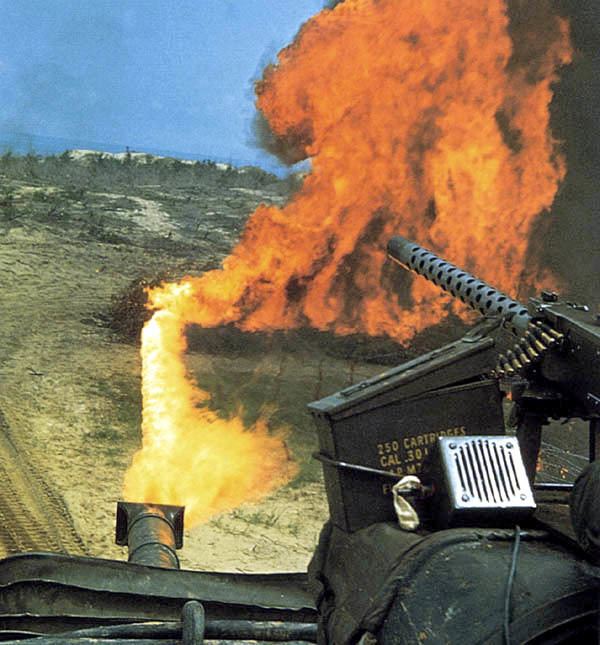 | ||
A flame tank is a type of tank equipped with a flamethrower, most commonly used to supplement combined arms attacks against fortifications, confined spaces, or other obstacles. The type only reached significant use in the Second World War, during which the United States, Soviet Union, Germany, Italy, Japan and the United Kingdom (including members of the British Commonwealth) all produced flamethrower-equipped tanks.
Contents
- Combat effectiveness
- German Army
- Italian Royal Army Regio Esercito
- Imperial Japanese Army
- Light Tank M3 General Stuart
- Medium Tank M4 General Sherman
- Tank Infantry Mk IV Churchill
- Tank Infantry Mk II Matilda II
- Medium Tank T 34
- Heavy Breakthrough Tank KV Klim Voroshilov
- Light Tank T 26
- Other
- Post war and Cold War tanks
- References
A number of production methods were used. The flamethrowers used were either modified versions of existing infantry flame weapons (Flammpanzer I and II) or specially designed (Flammpanzer III). They were mounted externally (Flammpanzer II), replaced existing machine gun mounts, or replaced the tank's main armament (Flammpanzer III). Fuel for the flame weapon was either carried inside the tank, in armoured external storage, or in some cases in a special trailer behind the tank (Churchill Crocodile).
Flame tanks are generally considered obsolete. No new models have been built since 1962, and their last use in any army was in 1974.
Combat effectiveness
In comparison to man-portable flamethrowers, flame tanks carried much more fuel, and could fire longer-ranged bursts. Due to their ability to get in range of enemy positions in comparative safety, they were invaluable for rooting out heavy infantry fortifications. For example, as no US tank cannon could possibly penetrate the thick bunkers created by the Japanese defenders on islands such as Tarawa or Iwo Jima, flame throwing tanks were used instead, while infantrymen provided the necessary security during their deployment.
The maximum range of a flamethrower was typically less than 150 metres. Because of this limitation, the flamethrower was virtually useless on an open battlefield. However, they proved a potent psychological weapon against fortified troops. In many instances, troops surrendered or fled upon seeing a flame tank fire ranging shots, rather than risk being burned alive.
Experience of combat use of flamethrower tanks was mixed. German flamethrower variants of Panzer II and Panzer III were both discontinued due to unsatisfactory performance and converted into assault guns or tank destroyers. The Panzer IV was never converted into a flame variant, despite having been configured for many other roles.
The mixed results were in part due to the development of infantry anti-tank weapons. At the start of the Second World War most infantry units had weapons with some effectiveness against armoured targets at ranges of thirty to fifty meters, like anti-tank rifles. Towards the end of the war, more powerful anti-tank weapons such as the bazooka, Panzerschreck, and PIAT were introduced which were fatal to tanks at ranges longer than the tank's flamethrower could reach.
While the British used a squadron of Churchill Crocodiles during the fighting at Brest in September 1944, the US Army received a smaller American designed flamethrower mounted upon the M4 Sherman tank during the same month. Assigned to the US Army's 70th Tank Battalion, the flamethrowing tanks went into action on 18 September 1944, where it was found that the weapons had a very short range as compared to the British Crocodiles, and consequently were not very popular amongst US troops.
The Canadian and Dutch armies became two of the most active users of the Wasp flamethrowers while fighting in Europe, finding the weapons to be extremely effective in prying German soldiers from their defenses. Indeed, the mechanical flamethrowers, although not impressive by themselves, struck horror into the minds of German troops, who feared them more than any other conventional weapon. Canadian troops used them during the Battle of the Scheldt.
Crews of 'flame' tanks were not necessarily more vulnerable than those crews in the regular, standard version of the tank (a Churchill 'Crocodile' flame tank being more or less as vulnerable to anti-tank weapons as the standard Churchill), but the crews of flamethrowing tanks were often treated differently should they be captured alive by enemy troops. Due to the perceived inhumanity of the weapon itself, captured crews of such tanks were often treated much less humanely than crews of regular tanks. Instances of 'flametankers' being executed by the opposite troops upon capture were not uncommon. Subsequently, British tank crews received sixpence a day extra 'danger money' due to the threat of arbitrary execution. Flame tanks also suffered from the fact, along with flamethrower-armed troops, that all enemy within range would usually open up on them due to the fear of the weapon.
Flame tanks were not necessarily more prone to catching fire or exploding, unless hit with an armor piercing round or explosive reaching the ammunition and fuel inside. Tanks such as the Churchill 'Crocodile', which towed the liquid container behind the actual tank, held no greater risk of fire than standard tanks. Although the towed container itself could be easily targeted, the tank and its crew were generally well protected.
